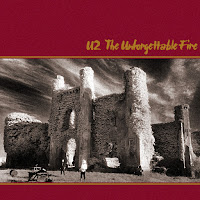 |
| David Bowie—Let's Dance |
The lyrically despondent, musically uplifting "Modern Love" kicks off the album with the waking guitar of either producer Nile Rodgers or special guest Stevie Ray Vaughan. The song consciously retrofits rock and roll with the trappings of then-current dance music, hence the joke: "There's no sign of life/It's just the power to charm ... Never gonna fall for/(Modern love) walks beside me." It's worth noting at this juncture that Bowie had been flirting with pop and new wave since Lodger (1979), though this is obscured by the pervasive notion that Lodger fit best with the Berlin narrative (Low and "Heroes" [1977]). Furthermore, Scary Monsters was markedly sinister in tone, which makes the disco-neutering all the more puzzling until it becomes apparent that Bowie attempted, at least in part, to convey this same sentiment with Let's Dance. If not, it's strange that he would decide to remake "China Girl" of all songs, the spasmodic centerpiece of Iggy Pop's The Idiot (1977), co-written by Bowie. "Let's Dance" hit #1 or #2 in most countries as a single, which was released both as a 7" in an abridged version and a 12" in its full album length of 7:38. It can either be interpreted as a love song or, given the album cover, a metaphor for pugilism. Its success is the reason why Let's Dance may also mark the point where David Bowie became truly accessible; it opened his music up to a whole new audience, much as atypical singles like "Fame" did before.
It's tough to regard Let's Dance as anything less than a smash success, given this onset of hits. Even from a traditionalist's mindset, they're worthy songs, if tumid in their way, much as the extended cuts of Station to Station were. The only problem was the supporting repertoire. Side closer "Without You" is a repetitive, bland piece of work. "Ricochet" has an uncanny quality but ultimately comes up short, never climaxing. Requisite cover "Criminal World" (Metro) neither adds nor subtracts from the experience. "Cat People (Putting out Fire)," with music written by Giorgio Moroder, was recorded originally in a more sparse, haunting arrangement for the 1982 film Cat People. Its inclusion either signaled Bowie's simple satisfaction with the song or was symptomatic of a larger problem: he was hitting a lean period in terms of songwriting inspiration (the follow-up album Tonight [1984] would feature a roughly equal number of truly new songs). "Shake It" is the definition of filler.
Let's Dance earns the dubious honor of being interesting on its own merits—"Modern Love" is one of Bowie's best songs in any era—but also a portent of substandard work by Bowie in the years to follow. Even apart from the history, however, it's one of his least challenging records, and some of the songs are flat-out unnecessary or monotonous.




